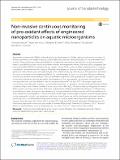Non-invasive continuous monitoring of pro-oxidant effects of engineered nanoparticles on aquatic microorganisms
Author(s)
Santschi, Christian; Von Moos, Nadia; Bowen, Paul; Slaveykova, Vera I.; Martin, Olivier J. F.; Koman, Volodymyr; ... Show more Show less
Download12951_2017_Article_253.pdf (3.315Mb)
PUBLISHER_CC
Publisher with Creative Commons License
Creative Commons Attribution
Terms of use
Metadata
Show full item recordAbstract
Engineered nanomaterials (ENMs) are key drivers for the development of highly sophisticated new technologies. As all new attainments, the rapidly increasing used of ENMs raise concerns about their safety for the environment and humans. There is growing evidence showing that if engineered nanomaterials are released into the environment, there is a possibility that they could cause harm to aquatic microorganisms. Among the divers effects triggering their toxicity the ability of ENMs to generate reactive oxygen species (ROS) capable of oxidizing biomolecules is currently considered a central mechanism of toxicity. Therefore, development of sensitive tools for quantification of the ROS generation and oxidative stress are highly sought. After briefly introducing ENMs-induced ROS generation and oxidative stress in the aquatic microorganisms (AMOs), this overview paper focuses on a new optical biosensor allowing sensitive and dynamic measurements of H[subscript 2]O[subscript 2] in real-time using multiscattering enhanced absorption spectroscopy. Its principle is based on sensitive absorption measurements of the heme protein cytochrome c whose absorption spectrum alters with the oxidation state of constituent ferrous Fe[superscript II] and ferric Fe[superscript III]. For biological applications cytochrome c was embedded in porous random media resulting in an extended optical path length through multiple scattering of light, which lowers the limit of detection to a few nM of H[subscript 2]O[subscript 2]. The sensor was also integrated in a microfluidic system containing micro-valves and sieves enabling more complex experimental conditions. To demonstrate its performance, abiotic absorption measurements of low concentrations of dye molecules and 10 nm gold particles were carried out achieving limits of detection in the low nM range. Other biologically relevant reactive oxygen species can be measured at sub-μM concentrations, which was shown for glucose and lactate through enzymatic reactions producing H[subscript 2]O[subscript 2]. In ecotoxicological investigations H[subscript 2]O[subscript 2]excreted by aquatic microorganisms exposed to various stressors were measured. Pro-oxidant effects of nano-TiO[subscript 2] and nano-CuO towards green alga Chlamydomonas reinhardtii were explored in various exposure media and under different light illuminations. Dynamics of Cd[superscript 2+] induced effects on photosynthetic activity, sensitisation and recovery of cells of C. reinhardtii was also studied.
Date issued
2017-03Department
Massachusetts Institute of Technology. Department of Chemical EngineeringJournal
Journal of Nanobiotechnology
Publisher
BioMed Central
Citation
Santschi, Christian et al. “Non-Invasive Continuous Monitoring of pro-Oxidant Effects of Engineered Nanoparticles on Aquatic Microorganisms.” Journal of Nanobiotechnology 15.1 (2017): n. pag.
Version: Final published version
ISSN
1477-3155